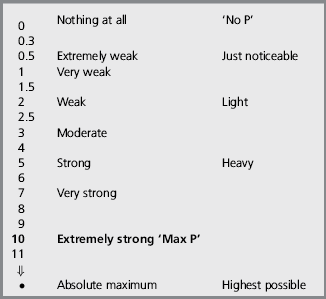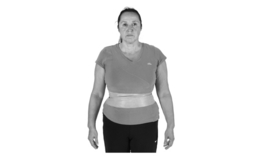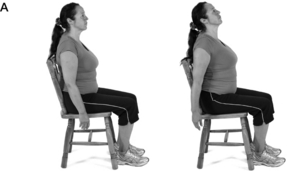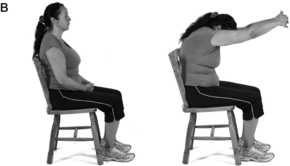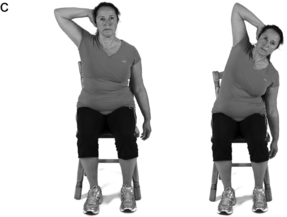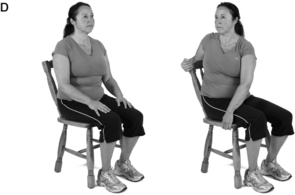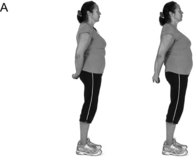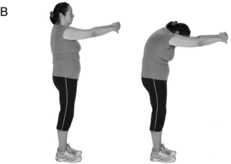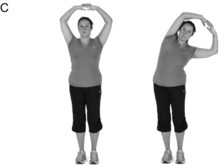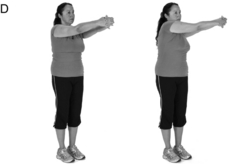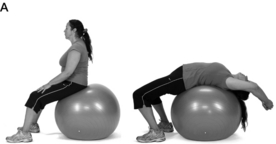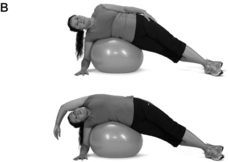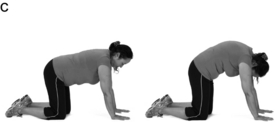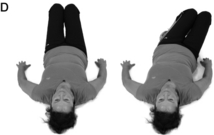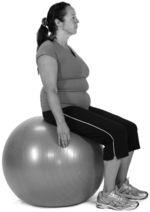Chapter 7
Functional training of the respiratory muscles
THE RATIONALE FOR FUNCTIONAL TRAINING
As was discussed in Chapter 3 (section ‘Non-respiratory functions of the respiratory muscles’), the role of the respiratory muscles extends far beyond that of driving the respiratory pump. This fact explains why most, if not all patients, find walking makes them more breathless than riding a stationary cycle ergometer. However, the contribution of the respiratory muscles to postural control (balance) and core stabilization is not addressed directly in a rehabilitation context. This is surprising because these non-respiratory roles have profound implications for how we should train these muscles to optimize their function and minimize the unpleasant symptoms that they generate. A detailed description of the trunk musculature and its non-respiratory roles can be found in Chapter 3. The current section will focus upon the specific rationale for functional training of the respiratory muscles.
Because of the multiple roles of the trunk muscles, respiratory muscle training cannot be optimized if it is delivered using an exclusively ‘isolationist’ model of training, i.e., if optimal function is to be achieved, the core stabilizing role of the diaphragm must be trained in the context of an activity that challenges core stability. Notwithstanding this, there remains a role for the isolated training of the ‘Foundation’ phase (see Ch. 6), which provides the foundation onto which functional training is built – in other words, an ‘isolate, then integrate’ approach to training.
As was explained in Chapter 5, muscles respond to training in highly specific ways that limit the transferability of training benefits when the training stimulus is non-functional (e.g., an isolated leg extension is unlikely to improve walking performance). In functional training, muscles are subjected to forces during functional movements in order to develop the neuromuscular system in ways that are transferable to real-world activities. To date, a missing element from the functional training repertoire has been any consideration of the role of respiratory muscles (major trunk stabilizers and controllers) in functional movements, and vice versa.
In his book on low back disorders, Professor Stuart McGill rightly highlights the specific challenge that elevated ventilation represents to spine stability, as well as the increased risk that it poses for back injury (McGill, 2007). The therapeutic approach suggested by McGill is to undertake a range of stabilizing exercises (e.g., side bridge) immediately after an activity that raises ventilation, the idea being that the resultant hyperpnoea is superimposed on exercises that challenge the stabilizing musculature. The aim is to produce what McGill calls a ‘grooved’ pattern of muscle activation, similar to a rope running in a well-worn slot, so that breathing and stabilization take place simultaneously but without any compromise to either. Often, people cope with their inability to meet the conflicting demands on their respiratory muscles by holding their breath during exercises such as a side bridge. This is clearly a bad ‘groove’ to get stuck in.
In addition to providing a stable platform, the respiratory muscles play an important role in postural control during brief perturbations to balance. A good example of this is the automatic, anticipatory activation of specific trunk muscles immediately before large arm movements (see Ch. 3). The role of the diaphragm in this type of postural control is pre-programmed (‘grooved’); this is known because diaphragm activation precedes movements that destabilize the body (Hodges et al, 1997a; Hodges et al, 1997b). However, this automatic activation does not mean that the programme is not dynamic or adaptable; rather, the programme varies according to the movement parameters of the task and according to factors such as the prevailing postural conditions (stable or unstable), muscle fatigue, injury, pain and so on. For muscles that are involved in automatic anticipatory postural adjustments, such as the transversus abdominis, isolated specific training can normalize previously abnormal patterns of motor activation, i.e., restore a programme to normality (‘flip the rope back into the groove’) (Tsao & Hodges, 2008). In other words, isolated voluntary training of muscles involved in automatic anticipatory postural adjustments leads to improvement in complex automatic control strategies. The similarity of the diaphragm’s role to that of the transversus abdominis makes it extremely likely that this effect is also present for the diaphragm. Therefore, isolated voluntary training of the diaphragm (the kind of training undertaken during Foundation IMT) most likely enhances its automatic functioning during complex movements. The implications of this pre-programmed role of the diaphragm also need to be considered, and they are incorporated within the guidance on functional training provided below.
ASSESSING PATIENT NEEDS
Historically, patients being considered for Foundation IMT have typically been assessed on the basis of their inspiratory muscle function, and specifically their maximal inspiratory pressure (MIP) (see Ch. 6, sections ‘Patient selection’ and ‘Assessment of respiratory muscle function’). However, as was explained in Chapter 6, there are a number of reasons why MIP is not a good predictor of the likely benefits of Foundation IMT, and especially of Functional IMT. First, although reference values for MIP exist, the measurement is not straightforward to undertake, the equations have very poor predictive power (Enright et al, 1994; McConnell & Copestake, 1999) and the definition of ‘weakness’ is primarily statistical and not functional (Enright et al, 1994). Secondly, although patients with a MIP < 60 cmH2O appear to show larger improvements than those with stronger inspiratory muscles (Lotters et al, 2002; Gosselink et al, 2011), those with stronger inspiratory muscles still show an improvement in breathlessness and exercise tolerance after IMT (Lotters et al, 2002). Thirdly, MIP takes no account of the demand side of the demand / capacity relationship of the inspiratory muscles; the closest functional correlates of dyspnoea are not indices of airway obstruction or gas exchange impairment, but rather inspiratory muscle function (O’Donnell et al, 1987; Killian & Jones, 1988) and the degree of lung hyperinflation (O’Donnell et al, 1998; Marin et al, 2001) – in other words, the relative load upon the inspiratory muscles. Finally, in the context of Functional IMT, MIP provides no insight into the conflicts that might exist between the respiratory and non-respiratory functions of the trunk muscles.
Accordingly, the use of functional, patient-centred indices would seem to be the most appropriate way to approach assessing the degree of functional overload of the inspiratory muscles, and thence the most appropriate approach to IMT. For severely incapacitated patients, Foundation IMT may be the most that can be achieved, but for those who are ambulatory, or have the potential to become so, functional training regimens can be developed. Since a functional approach has not been applied to date, there is no empirical evidence to guide the prescription of IMT based upon the demand / capacity imbalance principle. However, in order to ‘get the ball rolling’ in terms of generating functional, patient-centred indices of inspiratory muscle overload, one potential method is suggested below (see section ‘Assessment of load / capacity imbalance’). Prior to this, the assessment of dyspnoea is described briefly; as dyspnoea is not only the primary correlate of load / capacity imbalance, it is also relatively easy to assess.
Assessment of dyspnoea
Reflexive assessment of dyspnoea
Of the many reflexive methods available, two of the most widely used and best supported by evidence are the Medical Research Council (MRC) Scale and the Baseline Dyspnoea Index (BDI) and Transition Dyspnoea Index (TDI) (BDI-TDI). Copies of these instruments can be found in Boxes 7.1 and 7.2A,B, respectively. These scales provide a useful insight into the limitations imposed upon everyday life by dyspnoea. In addition, the BDI-TDI allows changes to be monitored in response to interventions or disease progression.
• What activities cause you to get out of breath, e.g., gardening, drying after bathing?
• How long can you do the activity for before you stop or slow down?
• What position are you in when you get breathless, e.g., standing?
• How breathless are you when you sit / stand / walk / etc. (a rating scale can be used to quantify this)?
• What activities have you changed or stopped doing because of breathlessness, e.g., gardening?
• How have you modified your activities because of breathlessness, e.g., sit instead of stand, use a walking aid?
• Do you ever lose your balance when you are out of breath, or feel that you need to steady yourself?
• Do you get low back pain, or feel your back is weak, or unstable?
Assessment of dyspnoea during exercise
The most commonly used and well-validated scale for the assessment of dyspnoea during exercise is the Category Ratio scale created by Borg (1982, 1998). This is a general intensity scale with ratio properties that can be used to quantify either breathing or limb effort independently, as well as concurrently within the same exercise test (Borg et al, 2010). A copy of the instrument and instructions for its use can be found in Boxes 7.3 and 7.4 respectively. Typically, the scale is presented to the participant periodically during exercise, and they report their perception verbally or by pointing at the scale. This enables symptom profiles to be generated, as well as isolated ratings at specified intensities of exercise. Furthermore, participants can be asked to exercise to a specified level of perceived effort for the purposes of exercise training, or to compare physical capacity between individuals.
Assessment of dyspnoea during loaded breathing
The Borg CR-10 can also be used during a loaded breathing task to assess breathing effort perception and its response to training (Weiner et al, 2000; Magadle et al, 2002; Weiner et al, 2003; Beckerman et al, 2005). Typically, participants breathe against a series of fixed-pressure threshold loads corresponding to unloaded breathing, and 5, 10, 20 and 30 cmH2O. After breathing against each load for 1 minute, participants provide an intensity rating using the Borg CR-10. Ideally, the test should be discontinuous such that each rating is discrete, independent of other ratings and unaffected by accumulated inspiratory muscle fatigue; randomization of load presentation is also recommended. The test is susceptible to differences in breathing pattern, so use of a breathing pacer is advisable (a breathing pacer App can be obtained at www.physiobreathe.com/apps).
No published data are currently available to define normal ranges for this test, but ratings of effort are inversely proportional to inspiratory muscle strength (MIP), and the test also exhibits excellent sensitivity to changes in MIP following IMT (Weiner et al, 2000; Magadle et al, 2002; Weiner et al, 2003; Beckerman et al, 2005). Since no normative data exist currently, it is recommended that practitioners / clinics develop their own methods and normative data for identifying patients with abnormally high ratings of dyspnoea. Notwithstanding the lack of published normative data, a look-up chart can be found in Figure 7.1 (see also section ‘Assessment of load / capacity imbalance’, below). It should also be noted that some patients with asthma may have abnormally low ratings (Kikuchi et al, 1994), which is a contraindication for IMT (see Ch. 6, section ‘Contraindications’).
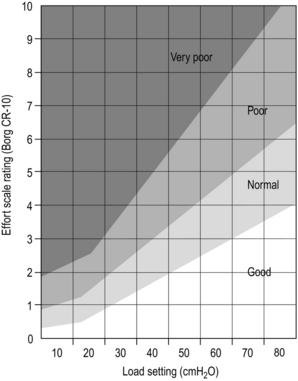
Figure 7.1 Load / capacity imbalance chart. Chart for assessing the extent of functional imbalance between the combined intrinsic and extrinsic loading of the inspiratory muscles, and the capacity of the inspiratory muscles to deliver inspiratory pressure. After breathing against a given load for 60 seconds, the participant rates their effort using the Borg CR-10 scale. Good = no imbalance and above average inspiratory muscle function.
Normal = no imbalance with normal inspiratory muscle function.
Poor = imbalance such that intrinsic and extrinsic inspiratory loading exceeds inspiratory muscle capacity.
Very poor = large imbalance such that intrinsic and extrinsic inspiratory loading exceeds inspiratory muscle capacity considerably. (The chart is based on unpublished data from McConnell and colleagues.)
Assessment of load / capacity imbalance
The look-up chart in Figure 7.1 can be used to assess the extent to which there is a functional imbalance between the combined, intrinsic and extrinsic loading of the inspiratory muscles and the capacity of the inspiratory muscles to deliver inspiratory pressure. The chart is based upon unpublished data collected from normal individuals and those with respiratory disease by McConnell and colleagues over the course of two decades. To undertake the test, the participant breathes against one to three inspiratory loads using the methods described in the section ‘Assessment of dyspnoea during loaded breathing’, above. The resulting Borg CR-10 rating can then be compared with the rating classifications on the chart.
FUNCTIONAL TRAINING EXERCISES
Underlying principles
Functional IMT should be preceded by a 6-week period of Foundation IMT, and the development of good diaphragm breathing technique (see Ch. 6). When embarking upon the Functional phase of training, it is important to ensure that patients have good technique and exercise form, before adding any resistances. Start patients off by performing each exercise with nothing more than a focus on maintaining slow, deep diaphragmatic breathing throughout. Using an external breathing pacer that provides an auditory cue (obtainable via www.physiobreathe.com/apps) can be very helpful for supporting this process, as well as during the functional exercises themselves. Next add an external resistance to inhalation using an inspiratory muscle-training device (IMTD) set on its minimum load. Gradually increase the load on the IMTD over a period of a few weeks until it reaches the prescribed level for the exercise. See Box 7.5 for guidance regarding abdominal bracing and achieving a neutral spine position, as well as the sections on breath control and load setting in Chapter 6. In addition, consider incorporating IMT into interval training, drills or circuits; the IMT can be introduced into the recovery phase of interval training, or it can be a separate station during a drill or circuit.
Before using these exercises, be sure to note the following principles:
• The limb resistances imposed using cords or bands should be low to begin with, but they can be increased as the training progresses. Don’t be too ambitious with the resistance, which is intended primarily to create a postural challenge to the trunk, not to create a resistance-training stimulus to the limbs.
• Ensure elastic resistances are under tension at the start of the exercise (see the previous point for guidance on resistance level).
• For exercises involving hand weights, if these are not available they can be substituted with other items such as cans of food or bags loaded with heavy items.
• For exercises that incorporate abdominal bracing (see section ‘Tips for Bracing and Posture’), add the IMTD only once patients able to force their diaphragm into the braced abdominal compartment.
• The compressive effects of tight clothing can be simulated by wrapping elastic resistance bands around the appropriate areas of the trunk (Fig. 7.3).

Figure 7.2 Neutral spine position; the pelvis is level. (From McConnell AK, 2011. Breathe strong, perform better. Human Kinetics, Champaign, IL, with permission.)
| Ideal equipment | Alternative equipment |
| Inspiratory muscle training device | Pursed lips with braced trunk |
| Swiss ball | Chair with balance cushion |
| Balance cushion | Close foot stance |
| Dumbbells (1–10 kg) | Canned food, small sand bags |
| Small medicine ball (2–10 kg) | Canned food, medium sand bags |
| Step | Stairs |
| Elastic resistance band or cord | |
| Exercise mat | Carpeted area |
| Bounceable ball | |
| Small shopping bag | |
| Chair with and without arms |
• Light: equivalent to the 50- to 100-repetition maximum (20–40% of MIP, or an effort rating of 2 to 3 on the Borg CR–10 scale)
• Moderate: equivalent to the 20- to 40-repetition maximum (50–60% of MIP, or an effort rating of 4 to 6 on the Borg CR-10 scale).
Some suggested workout protocols are provided at the end of this chapter, and video clips of all exercises are available at www.physiobreathe.com.
Stretching and mobilizing
Developing range of movement is as important for the thorax as it is for any other part of the body. However, the trunk and rib cage are often overlooked when it comes to these activities, despite the fact that these areas include numerous muscles, their attachments, and associated connective tissue (e.g., the rib cage). The rib cage is potentially a huge source of resistance to inhalation, especially in restrictive diseases such as kyphoscoliosis. Any resistance to thoracic expansion increases the work of breathing and the associated perception of breathing effort. The exercises below are grouped into sets of ‘Easy’, ‘Moderate’ and ‘Difficult’ exercises that stretch the trunk in the anterior, posterior and lateral planes, as well as during rotation. Easy and moderate stretches are based on those of Minoguchi et al (2002). These sets can be used to stretch and mobilize the rib cage in order to free-up rib expansion and reduce breathing effort. Each movement should be sustained at maximum range of movement for around 30 seconds.
Breath control
As was described in Chapter 6, developing breath control is a skill that can and should be practised, because it maximizes breathing efficiency and minimizes the distracting influence of dyspnoea. This can be practised in situations where breathing demand / distress is high; under these conditions, patients should be encouraged to practise deep, slow breath control, and to slow their breathing frequency as much as they can tolerate (a breathing pacer App can be obtained at www.physiobreathe.com/apps). Keeping breathing calm and relaxed under stressful conditions can help to minimize stress and anxiety, and build a sense of mastery.
In addition, below are three further exercises that can help overcome the urge to synchronize breathing with the cadence of movement, which is almost always too high. The exercises involve high-cadence body movements, during which the patient should practise deep, slow, controlled breathing that is deliberately not synchronized with movement (a breathing pacer App can be obtained at www.physiobreathe.com/apps).
Marching on the spot
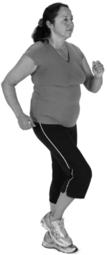
Procedure:: The patient should march on the spot at a challenging but manageable pace. This exercise will also increase breathing demand, and is therefore more difficult than the Swiss ball bounce. The natural urge will be to synchronize breathing to the cadence of the movement, but this should be replaced by a deep, slow breathing pattern that is deliberately slower than the movement, and asynchronous.
